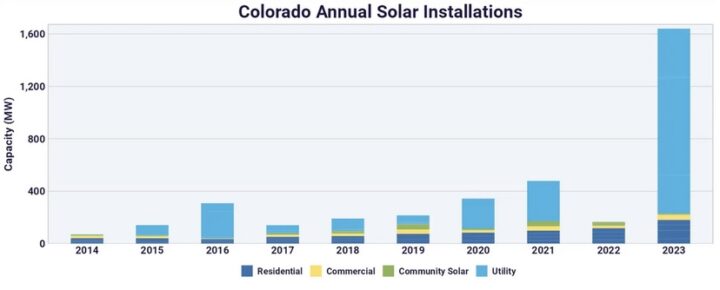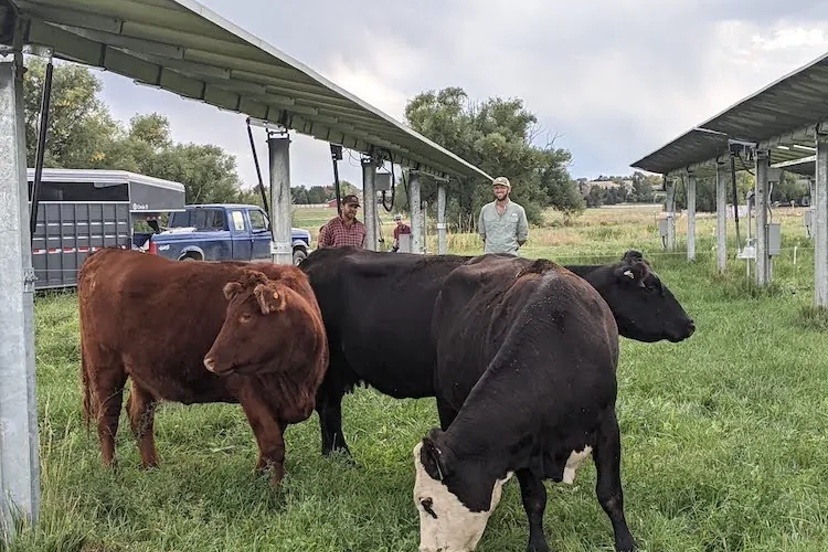Photo: Cows at Jack’s Solar Garden near Longmont, which has become the marquee place in Colorado for thinking about and studying the integration of agriculture and solar production. Courtesy of Jack’s Solar Garden.
This article series is excerpted from two stories by Allen Best that first appeared on BigPivots.com on September 10, 2024.
In simple acreage, Weld County is Colorado’s third largest. Because of flattish land and transmission access, it is also one of the most attractive to solar developers.
Maxwell Nader, the county planning manager, reports about 100 applications have been filed for solar projects since 2013. Some are five acres or so but a few run several thousand acres. The normal is 20 to 30 acres. The bulk have been in the Greeley area or around surrounding towns: Eaton, Severance and Johnston, among others.
In most cases, the solar projects are for farmland. The farmers say they need the supplemental income for their farming operations.
Unlike those of Mesa County, the regulations adopted by Weld County commissioners in 2021 make no mention of agrivoltaics. Despite that absence, many solar developers have been submitting proposals that include explicit plans for continued agricultural production – or, in a few cases, new agricultural production.
Proposals have been increasing, and a simple trigger for that has been a new requirement by Xcel Energy. Xcel has said that solar developers need to get local approval before applying to the utility. Before, it was get utility approval first and then the approval of the local jurisdiction.
“That (new procedure) really jumped our numbers very quickly,” said Nader.
For three years, Rhiannon Lawson and her husband, Jason, traveled across 40 states and five Canadian provinces before choosing to create a home and raise their boy in Colorado’s Mesa County.
The attraction?
“Well, first off is the sun,” said Lawson on a sunshine-splashed day in early June.
Lawson was looking out the 10-by 12-foot north-facing window of her family’s small house near Palisade. The landscape she and her family see is both sparse and dramatic. The small house sits on the side of a hill. Below is a thinly vegetated plain, a sort of fishbowl or amphitheater covered with cheatgrass and other vegetation that can survive on the sparse precipitation received there, just 10 inches annually. Beyond are the lush green orchards of peaches, pears, and plums irrigated by water from the Colorado River. The Book Cliffs, De Beque Canyon and Roan Plateau lie farther away.
The Lawsons grew up in western Washington where, she reported with authority, it rains nine months of the year. “It’s like the Prozac capital of the world. It’s just real dark.”
That same sunshine that made Mesa County stand out, though, makes it attractive to solar developers. The first solar application in the fishbowl below the Lawsons’ house arrived in 2018, two years before they built their house.
A solar developer named Pivot Energy had an option on land in the fishbowl and gained county approval for a two-megawatt solar project. It then decided it couldn’t make the economics work at that size. Pivot Energy consigned the rights to another developer, One Energy, which gained approval from Mesa County in November 2023 for a larger 4.5-megawatt project with 11,000 photovoltaic panels.
The Lawsons opposed that project, protesting the visual intrusion 200 vertical feet below their deck. They argued it would displace elk that gather during winter. Other neighbors also strenuously objected.
The neighbors made the case that the land-use regulations were somewhat vague regarding energy sources.
In response, the Mesa County Commissioners in January adopted a six-month moratorium on new utility-scale solar installations. The moratorium did not include residential.
This story won’t end with everybody happy in a kumbaya moment. The takeaway — at least for now – is that compromises were struck and Mesa County adopted new regulations governing new installations of solar and also other energy developments. This was done by May 2, remarkably in fewer than four months.

Mesa County’s work should be understood in the context of a dramatic shift in energy generation as Colorado retires all of its coal-fired power plants in little more than the next six years. New gas generation will be coming on line, but even more will come from wind and solar coupled in many cases with batteries.
A decade ago solar provided very little of Colorado’s electricity and was almost entirely confined to rooftops and relatively small solar projects of a few acres or less. Largely because of lobbying by solar advocates in 2016-2018, the amount of utility-scale solar generation surged in 2023.
This is just the beginning. Modeling conducted for the Colorado Energy Office points to a rapid growth in overall generating capacity from 15 megawatts to 25 gigawatts from 2019 to 2034. Most of that will be in wind and solar.
“It’s a good time to be a solar installer, to be a solar developer,” said Mike Kruger, the chief executive of Colorado Solar and Storage, in an April interview. “There’s a ‘gignormous’ market in Colorado. It’s heavily competitive, but it’s a big market.”
Mesa County’s new regulations are part of the work by local governments in Colorado to prepare for what lies ahead. Many have already adopted regulations, but some are still to come. They vary greatly.
Kelly Flenniken, the executive director of Colorado Counties, Inc., the non-profit consortium of county governments, emphasizes that “one size does not fit all in Colorado.”
The counties “value that autonomy” and want to create regulations that respect their community values while looking at the larger picture, she says.
A bill as originally written for introduction in Colorado’s 2024 legislative session would have created a statewide template. It was watered down substantially before introduction. Now a law, SB24-212 requires state assistance to counties in helping create land-use regulations governing renewable energy, if the local governments request it. The law also requires the Colorado Energy Office to complete a study by September 2025 to evaluate local government processes for the siting of renewable energy and energy transmission.
This is in line with what Colorado Counties, Inc. wanted. It allows counties to become thought leaders, to share what they’ve come up with.
The state study is to become a repository of best practices. Or, from the perspective of the solar industry, some worst practices, too.
But whether in uber-liberal Boulder County or arch-conservative Mesa County, the changing land use produces tensions that must be explored and balances that must be struck. In many eyes, Mesa County struck the right balance – at least for Mesa County.
Read Part Two, tomorrow…
Allen Best publishes the e-journal Big Pivots, which chronicles the energy transition in Colorado and beyond.

